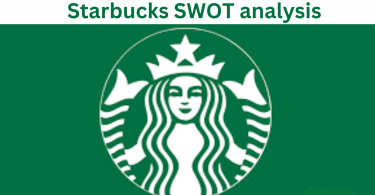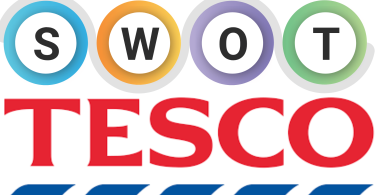A strategic analysis is vital for any company aiming to stay competitive and achieve long-term growth. It allows businesses to gain a comprehensive understanding of their internal capabilities and the external factors impacting their industry.
Canadian Tire, conducting a strategic diagnosis in 2024, is crucial to understanding the challenges and opportunities within the Canadian retail market.
The SWOT model is the ideal tool for this task. It assesses Canadian Tire’s strengths and weaknesses while identifying market opportunities and threats.
This approach allows Canadian Tire’s management to make informed decisions, align strategies, and position the company for sustainable success.
SWOT analysis of Canadian Tire
We now turn to the results of Canadian Tire’s SWOT analysis:
The internal analysis of Canadian Tire
The main goal of an internal analysis for Canadian Tire is to gain a deep understanding of its strengths and weaknesses, by evaluating its internal factors.
This self-assessment helps Canadian Tire management make informed decisions and develop effective strategies for the future.
Strengths of Canadian Tire
Canadian Tire has several strengths that distinguish it from competitors, particularly in the retail industry of Canada.
According to our investigation, we have found the following key strengths:
Strong Brand Recognition and Loyalty
Canadian Tire has maintained a trusted household name for over 100 years in Canada. A survey conducted by BrandSpark in 2023 ranked Canadian Tire as one of Canada’s most trusted brands in the retail sector, reflecting strong customer loyalty and recognition across the country.
In 2024, Canadian Tire’s loyalty program, Triangle Rewards, boasts over 11 million members. This extensive customer base allows the company to gain valuable insights and drive repeat purchases, providing a competitive edge over major retailers like Walmart and Home Depot.
Diverse Product Offerings and Store Formats
Canadian Tire offers a multi-category product mix, from automotive parts to home goods and sporting equipment. This diverse range allows the company to stand out from competitors like Walmart and Lowe’s, particularly in speciality categories such as automotive and outdoor recreation.
With over 1,700 retail locations across banners like SportChek, Mark’s, and Party City, Canadian Tire effectively captures various market segments, enhancing its position over more specialized retailers.
Omnichannel Retail Strategy
Canadian Tire’s investment in e-commerce and omnichannel strategies has yielded significant returns. By Q2 2024, online sales accounted for over 18% of total retail sales, up from 13% in 2021.
This seamless integration of online and in-store shopping experiences strengthens Canadian Tire’s competitiveness against global e-commerce giants like Amazon.
The company’s Click and Collect service enables customers to order online and pick up in-store within hours, offering a smooth and convenient shopping experience that positions Canadian Tire favorably against both physical and online retailers.
Financial Resilience and Operational Efficiency
Canadian Tire has demonstrated robust financial performance, with revenue for Q2 2024 exceeding $4.5 billion. This reflects the company’s steady post-pandemic recovery and resilience in challenging economic conditions.
A strong financial position allows Canadian Tire to invest in new initiatives and innovations, providing a competitive advantage over smaller, less financially stable rivals.
In the first half of 2024, the company’s gross margin increased by 8% compared to 2023, showing continued improvements in efficiency despite inflationary pressures.
Strategic Private Label Brands
Canadian Tire has successfully developed and promoted private-label brands such as Mastercraft, Motomaster, and Canvas. These brands offer higher margins than national brands and help differentiate the company’s product lineup from competitors.
In 2023, private-label products comprised approximately 30% of Canadian Tire’s total sales, underlining their significance in the company’s retail strategy.
These strengths give Canadian Tire a unique competitive edge, allowing it to perform strongly in the Canadian retail market, even in the face of intense competition from both domestic and international players.
Weaknesses of Canadian Tire
In 2024, Canadian Tire faces several weaknesses in comparison to its competitors, impacting its market performance:
Geographic Concentration:
Canadian Tire primarily operates within Canada, which limits its ability to diversify its revenue streams. Unlike competitors with a more global presence, this concentration exposes it to domestic market fluctuations and economic downturns.
E-commerce Challenges:
While Canadian Tire has invested in digital transformation, it still needs to work on keeping up with pure online retailers like Amazon, which provide better convenience and often lower prices.
Its dependence on physical retail locations creates operational complexities in adapting fully to e-commerce trends.
Supply Chain Vulnerabilities:
Canadian Tire’s supply chain efficiency has been affected by disruptions, which impacts inventory management and product availability.
This is particularly problematic during peak shopping seasons when delays or shortages can drive customers toward more agile competitors.
Declining Retail Performance:
In the second quarter of 2024, retail sales, excluding petroleum, fell by 4.7%, and overall comparable sales declined by 4.6%.
These declines reflect weaker performance in discretionary spending categories, creating pressure in segments like sports and leisure, where Canadian Tire faces fierce competition from specialized retailers.
Operational Complexity:
Managing a vast portfolio of brands and product categories—automotive and sports equipment—adds to operational challenges. This complexity makes it harder for the company to remain agile and responsive to market trends and competitive pressures.
These weaknesses highlight the areas where Canadian Tire needs to streamline operations, enhance its online offerings, and mitigate risks from supply chain disruptions to remain competitive in the evolving retail market.
The external analysis of Canadian Tire
The primary objective of conducting an external analysis for Canadian Tire is to understand external factors beyond its control that could influence its success in the global retail industry.
This analysis helps Canadian Tire management make well-informed decisions regarding its strategy, operations, and future trajectory. The external analysis delves into two main aspects: opportunities and threats.
Let’s move on to Canadian Tire’s current and potential opportunities and threats without further ado.
Opportunities of Canadian Tire
E-commerce and Omnichannel Growth
With the rise of online shopping, Canadian Tire has an opportunity to enhance its e-commerce capabilities and integrate online and in-store services for a seamless omnichannel experience.
Its e-commerce business has already shown significant growth, with a 65% increase year-over-year and 48,000 orders shipped during a peak period of just three weeks.
Scaling up its digital presence will help Canadian Tire attract more customers and better compete with online retailers.
Growth in Sports, Leisure, and Outdoor Segments
The surge in outdoor activities and sports post-pandemic offers further opportunities for Canadian Tire.
The company’s ownership of brands like SportChek positions it well to meet growing consumer demand for sports gear, camping equipment, and fitness products.
Despite challenging market conditions, SportChek sales decreased only 0.9% year-over-year in 2024, suggesting resilience and potential for growth.
Expansion of Private Labels and Exclusive Brands
Canadian Tire’s exclusive private labels, such as MotoMaster and Mastercraft, present an opportunity for higher margins and market differentiation.
Expanding these owned brands attracts customers and reduces reliance on external suppliers, giving Canadian Tire a competitive edge during economic downturns.
Sustainability and Eco-Friendly Product Offerings
The growing consumer focus on sustainability provides a chance for Canadian Tire to expand its range of eco-friendly products.
Emphasizing sustainable practices meets regulatory expectations and enhances the company’s brand reputation.
Strengthening Financial Services and Loyalty Programs
Canadian Tire’s financial services and loyalty programs offer additional growth opportunities.
Programs like Triangle Rewards, one of Canada’s most popular loyalty schemes, drive customer retention and spending.
Expanding personalized financial services like branded credit cards and in-store financing can deepen engagement and encourage long-term loyalty.
Technological Innovation and Automation
Canadian Tire’s investment in technology and automation opens new avenues for operational efficiency. In 2024, the company implemented goods-to-person automation in crucial distribution centers, enhancing supply chain management and reducing costs.
Additionally, AI-powered customer interactions have improved response times and increased sales conversion rates.
Real Estate Optimization and Expansion
Optimizing its real estate portfolio is another opportunity for Canadian Tire. The company’s ownership of retail properties provides flexibility in managing costs.
In 2024, Canadian Tire opened new stores across several provinces while selling off redundant properties, increasing liquidity and profitability.
International Market Expansion
Expanding beyond Canada presents a significant growth opportunity for Canadian Tire. By entering select international markets with products like automotive goods and sporting equipment, the company can tap into new revenue streams and reduce its dependence on the Canadian economy.
These strategic moves will help Canadian Tire align with market trends and position it for sustainable success in the evolving retail landscape.
Threats of Canadian Tire
In the Canadian retail industry, Canadian Tire faces several current and potential threats and risks that could impact its market position and profitability in the next years:
According to our research, we have noticed the following challenges:
Intense Competition
Canadian Tire operates in a highly competitive retail market, facing severe competition from both domestic and international companies, including big-box stores like Walmart, Costco, and Home Depot, as well as e-commerce giants like Amazon.
As of 2023, Canadian Tire held a market share of 10.8% in the hardware segment but faced stiff competition from other big-box and specialized stores with significant pricing power and extensive product ranges.
This competition has affected Canadian Tire’s retail sales, which decreased by 4.1% in Q2 2024.
Economic Fluctuations and Consumer Spending Trends
Economic downturns, inflation, and changes in consumer spending patterns can negatively impact Canadian Tire’s revenue.
In Q2 2024, Canadian Tire’s retail sales (excluding Petroleum) dropped by 4.7%, reflecting weakened consumer spending on discretionary categories, indicative of tighter household budgets amid inflation.
Moreover, retail return on invested capital (ROIC) decreased to 8.5% in Q2 2024 compared to 11.2% in the same quarter of 2023, further indicating financial pressure.
Changing Consumer Preferences
Consumers increasingly prefer online shopping, which can challenge traditional brick-and-mortar retailers like Canadian Tire.
Despite significant investments in digital transformation, Canadian Tire still needs to catch up to pure online retailers in terms of convenience, price competitiveness, and online presence.
The company’s e-commerce growth faces hurdles from platforms like Amazon, which often offer a broader selection at lower prices.
Supply Chain Vulnerabilities
Disruptions in the global supply chain caused by natural disasters, pandemics, or geopolitical issues pose a significant risk to Canadian Tire.
For instance, global supply chain disruptions during the pandemic and subsequent periods affected Canadian Tire’s ability to maintain inventory levels, resulting in gaps in product availability and customer dissatisfaction.
This challenge is particularly critical during peak seasons when product shortages can lead to missed sales opportunities.
Economic Dependence on Canada
Canadian Tire’s heavy reliance on the Canadian market exposes it to risks associated with domestic economic fluctuations, such as changes in employment rates or consumer confidence.
Unlike global competitors, Canadian Tire lacks geographical diversification, which makes it more vulnerable to Canadian economic downturns or fluctuations.
So, this geographic concentration limits its ability to mitigate risks through exposure to international markets.
Cybersecurity Threats
The increased focus on digital channels and e-commerce exposes Canadian Tire to cybersecurity risks, including data breaches and financial fraud.
As retail continues to shift towards online platforms, the threat of cybersecurity breaches becomes more significant.
Any data breach can lead to loss of customer trust, financial losses, and legal penalties, making cybersecurity a critical threat in the current retail landscape.
Regulatory and Environmental Changes
Changes in environmental regulations, trade policies, or labor laws could increase operational costs for Canadian Tire.
Regulatory changes like stricter environmental laws can affect product packaging, disposal requirements, and overall operational costs.
For example, increasing consumer demand for sustainability could require significant investments to align products and supply chains with new environmental standards, impacting profitability.
Fluctuating Currency Exchange Rates
Canadian Tire imports a substantial portion of its merchandise. Fluctuations in the Canadian dollar can affect costs and profit margins.
For example, a weaker Canadian dollar makes imported goods more expensive, which could lead to increased product costs and reduced profit margins, making it harder to compete with other international retailers that have better control over costs through currency diversification.
Retail Industry Evolution and Digital Competitiveness
The rapid evolution of the retail industry, driven by technological advances, demands ongoing investment to keep up with competitors.
While Canadian Tire has made strides in its digital strategy, its reliance on physical stores and the complexities of managing multiple brands and products can hamper its agility compared to leaner, purely digital competitors like Amazon, which continue to dominate online retail.
These threats illustrate Canadian Tire’s complex challenges in maintaining its market position.
To counter these risks, Canadian Tire must further enhance its digital capabilities, diversify geographically, and streamline operations to respond quickly to competitive and regulatory pressures.
Canadian Tire SWOT analysis matrix
To summarize the results of the Canadian Tire SWOT analysis, we present the following SWOT matrix:

Conclusion
In conclusion, Canadian Tire has several key strengths, including its strong brand reputation, extensive network of retail locations, and diverse product offerings that cater to various customer needs.
However, it faces weaknesses such as reliance on the Canadian market and challenges maintaining consistent digital transformation efforts.
Growth opportunities include expanding its e-commerce platform, capitalizing on emerging retail technologies, and further diversifying its product lines to meet evolving customer demands.
Nevertheless, threats like rising competition, economic fluctuations, and shifting consumer preferences remain significant challenges.
Canadian Tire should strengthen its online presence and enhance its digital capabilities to ensure sustainability and growth. It should also explore new markets and product categories to diversify its revenue streams.
Additionally, investing in customer experience and loyalty programs can help the company maintain its competitive edge and secure its position in the Canadian retail industry for the long term.
Read also: PESTEL analysis of Canadian Tire in 2024.
SWOT Analysis Examples 2024
There is no better way to understand how to conduct a SWOT analysis at your company than with a concrete example.
Below you will find our free, up-to-date, and concrete examples of SWOT analyses of large companies and multinationals conducted in 2024.












Leave a Comment